Uncovering The Oriental Theatre’s Mysterious Tiles
An inside tour of art tile in Milwaukee.
New evidence shows the American Encaustic Tiling Company from Zanesville, Ohio, created the original faience tiles at the Oriental Theatre, 2230 N. Farwell Ave.
When The Milwaukee Sentinel featured the Oriental in the newspaper on the day it opened on July 2, 1927, many companies involved in the construction of the East-India-themed theater were featured. The handmade faience tiles and regal coalition of lion statues, however, were not given the same spotlight.
Faience art tiles were placed in virtually every movie theater in the mid-1920s, especially in southeastern Wisconsin. As for theaters designed by architects Dick & Bauer, tile installations were also at the entrances and lobbies in the National and Tower theaters in Milwaukee, the Capitol in Racine, and the Sprague in Elkhorn. The Oriental was the firm’s grandest showcase of faience tiles.
In 1927 article, architect Alexander Bauer said of his own design: “Never before in history has a theater been planned, as has the Oriental theater, where tile has been so extensively used for decorative purposes in the lobby. Every single piece of the thousands of pieces of tile used in this theater lobby was specially designed and manufactured. Much of the tile is hand decorated. The tile work in this theater is so unusual and striking as to make one want to stand and gaze in wonderment and admiration.”
A flattering description for the artists who hand-painted all these tiles, who unfortunately were not mentioned.
What the article did share was that the tiles were installed by the Stark Mantel & Tile Co. This is the only official documentation we have for the people involved in the tile. Tile setting, respectfully, is its own type of art. Therefore, it is odd when the Sentinel describes so many other details but does not mention the tile-makers themselves.
Now for the technical part of this mystery.
Another site with installations in Milwaukee with similar glazes to the ones at the Oriental is Mount Mary University‘s Notre Dame Hall and Caroline Hall. The tiles in the vestibules in these two school buildings are attributed to the American Encaustic Tiling Company (AETCO) from Zanesville, Ohio. AETCO was one of America’s largest tile manufacturers and was in operation from 1875 to 1935. Several prominent tile historians say that these tiles at Mount Mary were manufactured by AETCO because the stock tile designs of stylized plant patterns were from that company.
These tiles, interestingly, were done in the same hand-painted glazing technique as the ones at the Oriental: cuerda seca. This historically Spanish/Moorish and Iranian style of glazing involves a wax substance mixed with minerals that is applied to the lines of a transferred image on bisqued clay (clay that has been fired once already at a low temperature to facilitate glaze application). Once the tiles are fired in a kiln, the wax burns out and leaves a dark, dry line in its place.
Furthermore, if you place photographs of the tiles from Mount Mary next to the ones at the Oriental, the glazes are an exact match, or rather, as exact as the glazes can be. These matte glazes were prized for their uniqueness due to the microcrystalline formations of each tile that had subtle, and sometimes grand, variations depending on its kiln firing process.
One picture shows a green glaze with pale blue formations on the surface on a decorative insert at Mount Mary compared to glazed tiles at the Oriental. The resemblance is striking.
Another one shows an orange glaze with golden and blue formations that appears on the tiles at each site.
AETCO also produced a line of gold-glazed tiles, which can be seen at both sites as well.
On the landing were many matte glazed tiles like those in the vestibule, installed in a method where large areas surrounding tiles are filled in with concrete. The arrangement of tiles creates a curve, possibly drawing an aisle or lane for people using the stairs.
More tiles along the risers are in the cuerda-seca style with dry, black lines dividing glazes into beautiful, floral shapes. Thanks to Norman Karlson for publishing images of his tile collection in his book American Art Tile, we know that the manufacturer of these floral tiles is none other than American Encaustic Tiling Company.
Interestingly, since Putskey observed that the stairs were covered with carpet in a photograph of the lobby when the theater first opened, it is most likely that these tiles have never been exposed to the public before.
One more piece of evidence points this installation to AETCO: the men’s and women’s lounges. Being one of America’s largest tile manufacturers, AETCO specialized in various types of floor and wall tile of every description, including ceramic mosaic tiles sometimes called Gobelin tiles. AETCO’s Gobelin mosaic tiles were suitable for unique patterns like those of the arrows at the Oriental, and they were considered ideal for smoke rooms. These mosaics were also installed in other theaters.
Lastly, there is one more tile feature at the Oriental that cannot go without recognition: the lions, of course. AETCO was capable of producing large statue-like tiles as these lions. And the lions look like they might have been placed above two large blue tiles. It is all in fact one piece, with false grout lines carved into the blue-glazed base. The glazes on the lions also match the other black glazes in the installation.
Due to these observations, it most likely that the American Encaustic Tiling Co. was the manufacturer of all the original tiles at the Oriental, especially since we know the floral tiles are by AETCO and the unique matte glazes on the lobby tiles match glazes in other tile AETCO installations.
And while the answer to that mystery comes to light, another one remains: will the carpet covering the faience tiles on the stairway be removed?
Whether the unveiling of the tiled staircase ever moves forward or not is something that Milwaukee Film will decide in future restorations. In a nearly 100-year old building, there is no shortage of projects. Putskey, who has worked at the Oriental for 17 years and is the longest-serving employee at the institution, is valued for his experience and expertise.
Putskey’s stewardship is why the faience tile floor is in the condition it is. A year ago, he patiently cleaned the grout by hand on the entire lobby floor. The job was no ordinary task. There are many ways to ruin historic tile flooring, but Putksey avoided that by diligently troubleshooting methods that would safely clean the floor. After spending approximately 12 hours with a steam cleaner and not-too-stiff nylon brush, the positive results of his method are evident.
Cleaning historic tiles and resealing the grout is not easy, but it’s worthwhile. The original Arts & Crafts tiles are highly valuable and are something that keeps the theater an architectural treasure in Milwaukee. It would be impressive if the carpet was removed from the original tiled staircase, but it may never happen.
Until then, these floral tiles can be seen in nearly mint condition on the façade of a building on National Avenue, with other AETCO tiles found in Karlson’s tile book.
Update November 28:: Ryan Putskey recently looked through the attic and found tiles left over from a remodeling project. The manufacturer labeled on the back was no other than American Encaustic Tiling Company, confirming that the tiles were in fact created by AETCO.
Photos
This is the fifth in a series of stories on tile artworks in Milwaukee by writer Ben Tyjeski, an art teacher who was named a 2023 Mildred L. Harpole Artist of the Year by the Milwaukee Arts Board.
If you think stories like this are important, become a member of Urban Milwaukee and help support real, independent journalism. Plus you get some cool added benefits.
Tile Town
-
Washington High School’s Tiled Bubblers Are Unique
 Apr 23rd, 2024 by Ben Tyjeski
Apr 23rd, 2024 by Ben Tyjeski
-
Nursery Rhyme Fireplace in a “Kindergarten Suite”
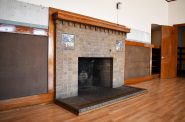 Oct 27th, 2023 by Ben Tyjeski
Oct 27th, 2023 by Ben Tyjeski
-
Will Unique Downtown Mural Be Saved?
 Jun 21st, 2023 by Ben Tyjeski
Jun 21st, 2023 by Ben Tyjeski


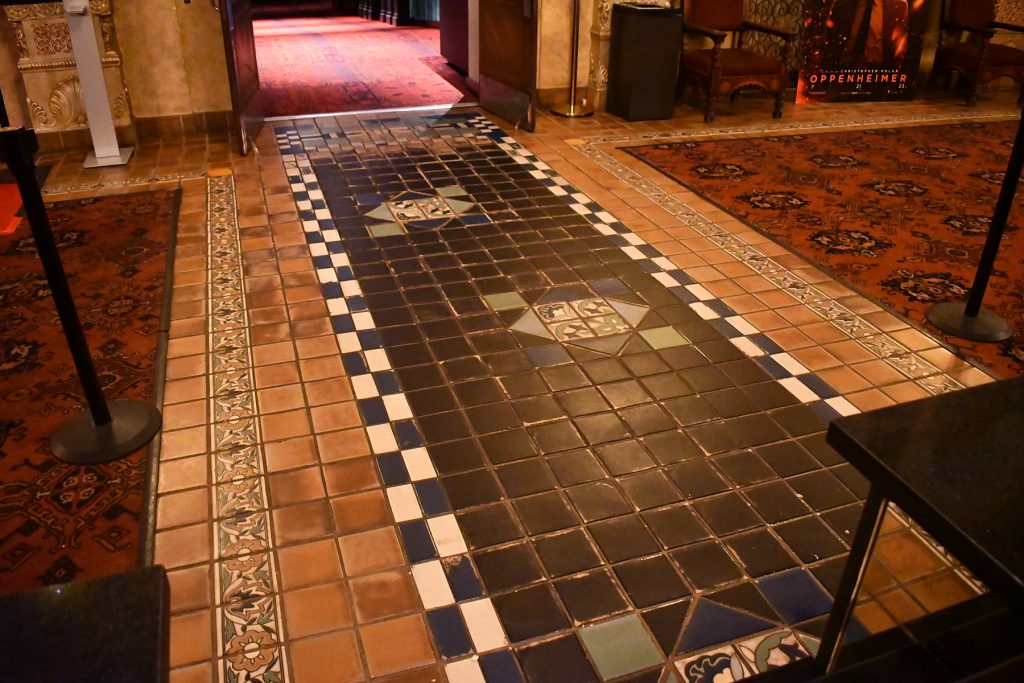
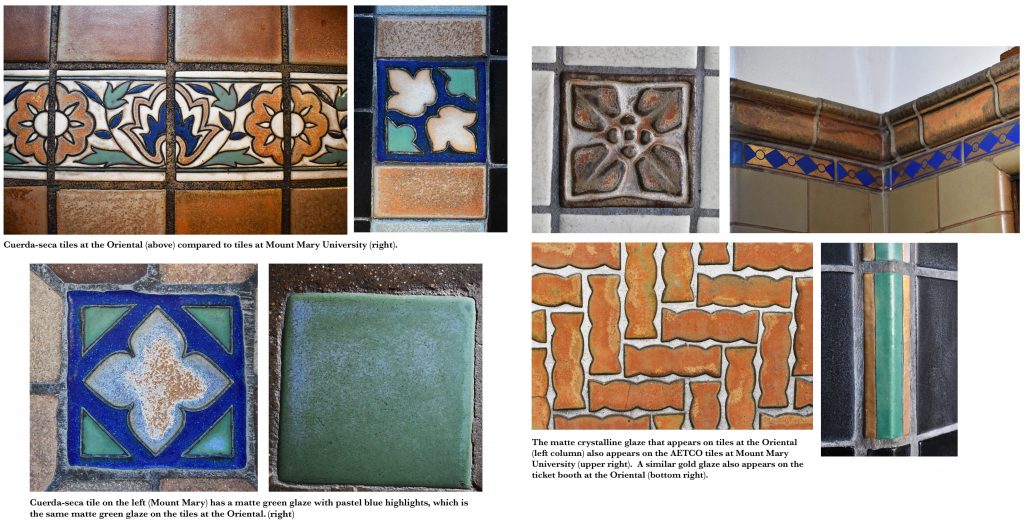
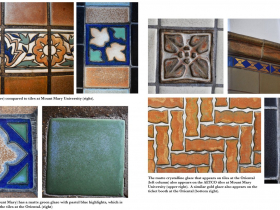
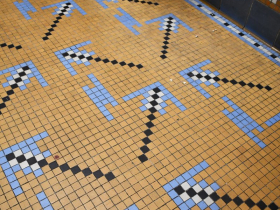
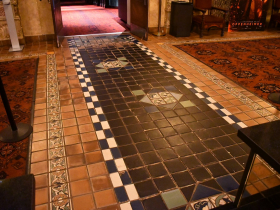
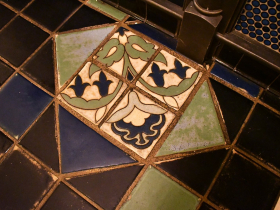
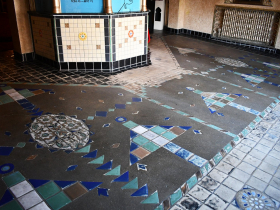
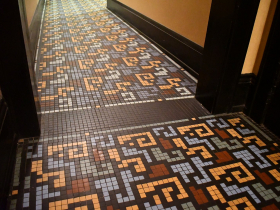




















The tile work in the old men’s room hallway makes a cameo appearance in the 2002 film “Britney, Baby, One More Time”
starring Milwaukee filmmakers Mark Borchardt and, the late, Mike Shank.
Love this story! Good sleuthing!